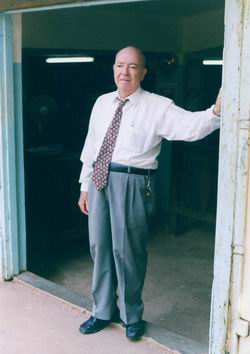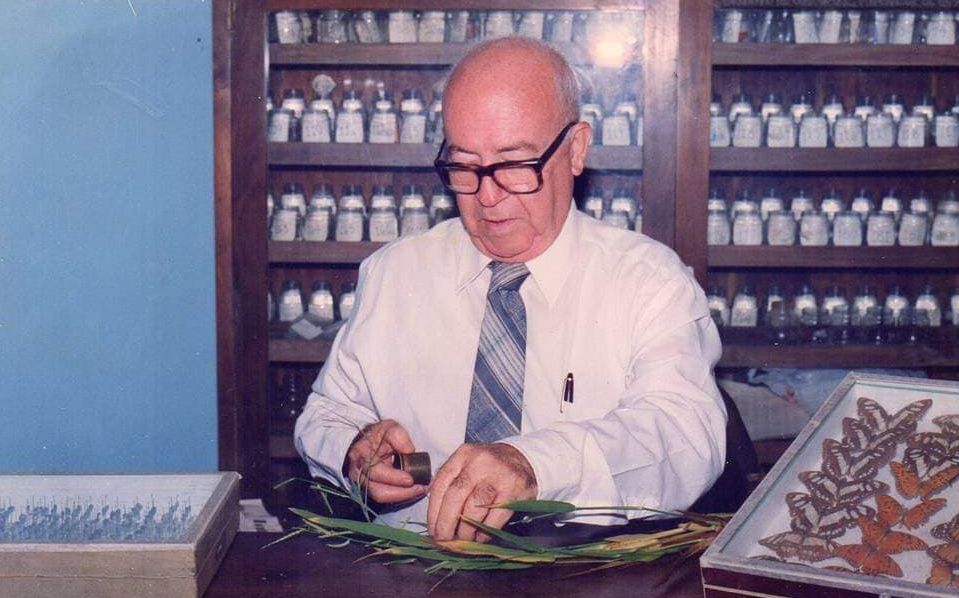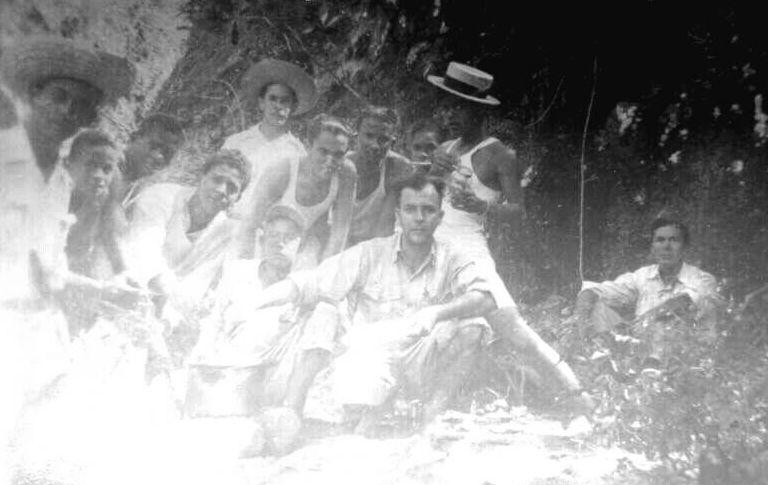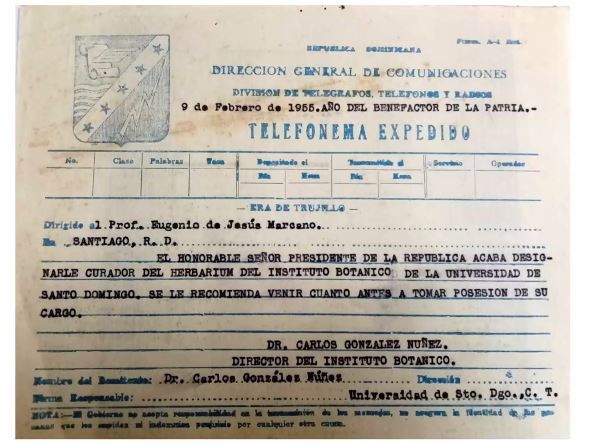Eugenio de Jesús Marcano Fondeur (1923-2003)
Naturalist, paleontologist, botanist, entomologist, educator
- Marcano’s main page
- Biography (En español)
- Portraits and tributes
- Publications
- Conferences
- Honors received and societies he belonged to
- Species dedicated to him
- Nature’s namesake (by Félix Servio Ducoudray)
- Marcano’s Pereskia
- Bánica’s Rose: Unique Plant of the Dominican Republic (by Geraldino Caminero)
- Poetry
- Photographs
- Videos
- Newspaper articles
- National Museum of Natural History Prof. Eugenio de Jesús Marcano
- Santiago Botanical Garden Prof. Eugenio de Jesús Marcano Fondeur
- Eugenio de Js. Marcano Fondeur Politechnic – Mata de Palma, San Antonio de Guerra
- Eugenio de Jesús Marcano High School– Tamboril
- Eugenio de Jesús Marcano primary school- San Pedro de Macorís
Biography1
The beginnings
Professor Eugenio de Jesús Marcano Fondeur was a prestigious Dominican naturalist. He was a researcher in the fields of botany, zoology, geology, and paleontology; an educator and teacher of generations; an active science communicator; and a fervent defender of our natural resources.
He is recognized as one of the most outstanding Dominican naturalists both for the diverse areas of study he pursued and for his extensive work in educational institutions, publications, and hundreds of conferences at the national and international level.
He was born on September 27, 1923 in Licey al Medio (also known as Licey of the Marcanos or simply Los Marcanos), belonging to the Tamboril municipality (Santiago Province), Dominican Republic. His parents were Jesús María Marcano Santana (Pía), from the same Licey al Medio, and Clemencia Bienvenida Fondeur (Mita), a native of Hatillo Palma, in the Northwest. The couple had five children: Eugenio de Jesús (“Geno”), Luz María (“Mía”), Carmen Dilia (“Llilla”), Luis, and Rafael (Fei). All currently deceased. Before marrying Clemencia, Jesús María had Efraín, also deceased.
He completed his first education in the elementary school of Licey al Medio, then went on to the Primary School of Tamboril, where he completed his primary studies. He moved to Santiago de los Caballeros to continue his secondary studies at the Ulises Francisco Espaillat Secondary School, where he obtained the title of Normal Teacher of First Education. At the same time, he studied business (accounting, typing).
After graduating, he started working as an accountant for some commercial companies, as well as starting some small businesses of his own.
In April 1947 he married Consuelo Martínez, from Tamboril. They had five children: José Eugenio, Clemencia Consuelo, Jesús María, Matilde Asunción and Eugenio de Jesús.
Years in Sabaneta
Shortly after the Santiago Rodríguez province was created (1948), he moved to his capital city, Sabaneta, where he worked for a time as an accountant at Banco Agrícola. He then founded (1949) the Escuela de Comercio San Ignacio, the first school of commerce in Sabaneta.
During his stay in Sabaneta, he used to go on excursions to neighboring areas. It is at this stage that he begins to deepen the study of geology, especially paleontology, due to the notable presence of several Miocene geological formations (Gurabo, Cercado, among others) with a notable abundance of fossils.
…the best university I’ve attended is having lived in Santiago Rodríguez2
Years in Santiago
In 1953 he was appointed Professor of Botany at the Emilio Prud’Homme Normal School, in Santiago de los Caballeros, returning to reside in said city. That same year he was also appointed professor at the Ulises Francisco Espaillat High School and at the Santiago Commerce Academy.
During these years in Santiago, he continued making excursions for geological and botanical surveys, frequently accompanying doctors Santiago Bueno and Federico Lithgow, nature lovers and great connoisseurs of our mountains. He also accompanied and collaborated with whom he always considered his masters: the eminent Dominican botanist Dr. José de Jesús Jiménez Almonte and Prof. Ricardo Ramírez, the first Dominican paleontologist.
Years in Santo Domingo
On March 5, 1955 he was appointed, on the recommendation of Dr. Jiménez, Curator of the Herbarium of the University of Santo Domingo, USD (currently Universidad Autónoma de Santo Domingo, UASD), subsequently occupying the Chair of Botany in the old Faculty of Pharmacy, and latter professor of Entomology. Almost at that same date, he was appointed Professor of Botany and Entomology at the Loyola Polytechnic Institute of San Cristóbal.
In 1958 he participated with Doctors Clayton Ray and Stanley Rand, from the Museum of Comparative Zoology of Harvard University in a survey of practically all the caves in the country. In this expedition the remains of a fossil Insectivore new to science were discovered and named, by Dr. Patterson, as Antillogale marcanoi (later changed to Solenodon marcanoi), the first biological species to bear Professor Marcano’s name.
In 1963 the Pan American Union made an evaluation of the country’s natural resources. Professor Marcano accompanied and advised Humberto Tasaico, ecologist of said organism, in the characterization and delimitation of the life zones according to the Holdridge system. These evaluations were eventually published on 1967 by the Pan American Union as “Reconocimiento y Evaluación de los Recursos Naturales de la República Dominicana: Estudio para su Desarrollo y Planificación”, one of the most complete evaluation of the natural resources of the country for many years.
In 1964 Marcano was appointed Director of the Botanical and Zoological Research Institute of the Autonomous University of Santo Domingo, when the current director Dr. Carlos González Núñez retired. Marcano held this position until his death.
With the arrival in the country of Father Julio Cicero, S.J. in 1968 a team of professor researchers was formed who gave impetus to biological and ecological research and teaching. They were later joined by Professor Idelisa Bonelly, who dedicated herself to the field of marine biology. These researchers created the School of Biology at the Autonomous University of Santo Domingo in 1968.

For his extraordinary scientific and educational work, on February 8, 1978, the Autonomous University of Santo Domingo (UASD) awarded him the title of Doctor Honoris Causa in Biology. Other educational institutions also granted him honorary titles years later (see “Honors Received” section).
He was one of the founding members and Member of the Academy of Sciences of the Dominican Republic (1974) and also founding member of the Societies of Botany, Entomology, and Orchids in the Dominican Republic. He was also the first scientific advisor to the recently inaugurated Dr. Rafael Ma. Moscoso National Botanical Garden in 1976.
In 1978 he took charge of the National Museum of Natural History with the position of Director, the first scientific director of that institution, a position in which he remained until 1982 (since 2012 this institution has been named after him). During this period, an activity that had already begun before and which continued after leaving the Museum was strengthened: scientific excursions or, as they called it, “Science Excursions”, with Father Julio Cicero and the journalist Félix Servio Ducoudray. They were frequently accompanied by Agronomist Abraham Abud Antún (“Bambán”), Marcano’s student in the full sense of the word, and other national and international researchers. These excursions were carried out every weekend to different parts of the country and were reported in the Saturday supplements of the newspaper El Caribe between 1978-1989. A compilation of all these stories, with the name of “Dominican Nature” (Naturaleza Dominicana) was published by the León Jimenes group in 2006.
In 1983, the Academy of Sciences of the Dominican Republic awarded him the Annual Science Prize in recognition of his scientific work in the country over the years.
He was the author of numerous scientific publications and collected thousands of plants, insects, fossils, arachnids, and many other biological specimens, discovering more than 300 new species for science, in addition to hundreds more new to the country. His collections of tens of thousands of specimens are mainly deposited at the Institute of Botanical and Zoological Research at UASD, where he dedicated many years of his life, and at the National Museum of Natural History. Many specimens collected by him are also found in collections at universities and international research centers. National and international scientists have named a total of 18 species of plants and animals in his honor.
In addition to his significant scientific work, one of his greatest impacts in the country was his immense contribution as an educator. Beyond his academic duties, Marcano disseminated scientific knowledge throughout the country by offering hundreds of educational lectures across the nation and internationally, covering topics ranging from poisonous plants, beekeeping, geology, zoology, ecology, and conservation, among others.
Eugenio de Jesús Marcano Fondeur passed away in Santo Domingo on September 18, 2003.
In 2008 his birthday, September 27, was declared “National Biologist Day”by the presidential decree #215 in honor of one of the country’s foremost naturalists and celebrated every year by multiple activities in the country.
In 2012, by the presidential decree #442 the National Museum of Natural History of the Dominican Republic changed its name to National Museum of Natural History “Prof. Eugenio de Jesús Marcano”.
In 2017, the presidential decree #217 created the Prof. Eugenio de Jesús Marcano Fondeur Botanical Garden in the city of Santiago.
Also several schools, parks, and streets in the country also bear his name (see honors).
Marcano was considered by many to be the ultimate naturalist of the Dominican Republic, used this term to designate people who, without specialized academic training in the area of their interest to which they dedicate long years of studies, manage to become, due to their tenacious perseverance and exceptional observation skills, in great connoisseurs of the different aspects of natural history.
As a product of almost 50 years of fruitful teaching activity, Marcano created a legion of students that he left scattered throughout the national territory.
La Naturaleza Dominicana3
…Professor Eugenio de Jesús Marcano has been a sort of guide, a role model, because for us, he is a pioneer of Dominican geology. At a time when practically no one was interested or enthusiastic about studying sedimentary formations in this country, the professor was out by the Mao River sampling the Cercado Formation, the Gurabo Formation, and in Isabela studying the reef limestones in the western part of Puerto Plata, as well as in Los Haitises studying the Cevico limestones and the limestones of Los Haitises. In other words, things that many young people could have done but didn’t, Professor Eugenio de Jesús Marcano has been doing. For us, this is extraordinary because he never fears the weather conditions or the adversities of fieldwork. In the field, he is always ready to face challenges, even thorns, and in that, the professor has been an exemplary figure.
– Rafael Osiris De León2
Notes
- Biographical data provided by the Marcano-Martínez family
- Carlos T. Martínez. 1996. Grandes Dominicanos. Tomo II. Producciones Catemar. Santo Domingo
- Arístides Incháustegui and Blanca Delgado Malagón. 2006. La Naturaleza Dominicana. Tomo 6, pg 368. Grupo León Jiménez, Santo Domingo



